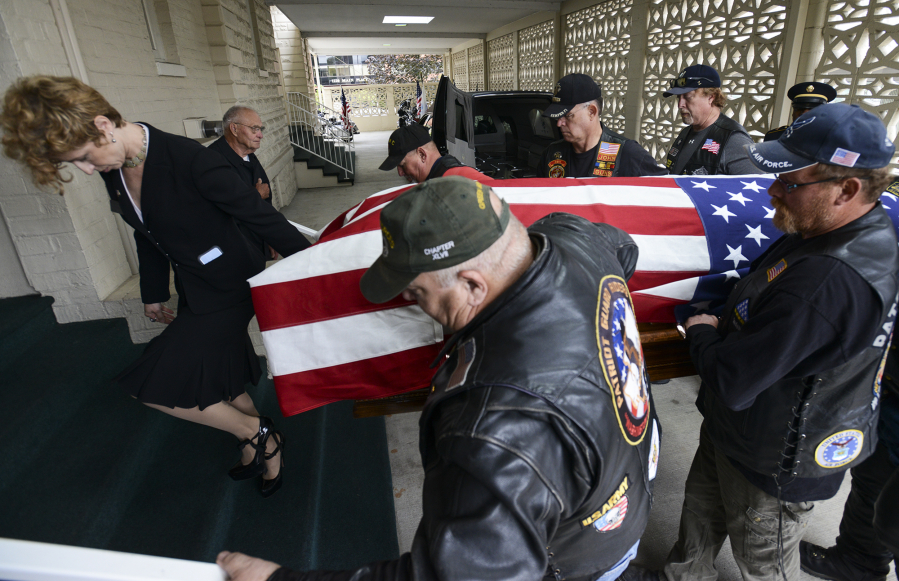When Billy Butz decided 66 years ago to join the Army, he asked his older sister for a favor. At 17, Billy was not old enough to enlist without parental approval.
So he lied about his age. He also had Betty forge their mother’s name on a note, just in case he needed some documentation.
“It’s what he wanted,” the soldier’s sister, now Betty Hein, said Tuesday.
Butz was killed in the Korean War, and the family never saw him again. Butz was declared missing in action on Dec. 12, 1950.
But on Tuesday afternoon, Betty was sitting a few feet from her brother’s casket.
The remains of U.S. Army Pfc. William R. Butz were returned home to Vancouver after spending decades in a grave for an unknown soldier. Local Patriot Guard Riders escorted the casket from Portland International Airport to Vancouver Funeral Chapel.
Butz will be buried with full military honors at 11 a.m. Friday at Evergreen Memorial Gardens, 1101 N.E. 112th Ave., Vancouver, in the Arlington West section.
The public is invited to attend the graveside service.
Gary Hein and Betty met in 1965, so he never knew Billy. But as a veteran of the U.S. Army’s 10th Mountain Division, Gary was very interested in the fate of his brother-in-law.
“Before I showed up, the family tried to find out what happened, but all they knew was Dec. 12,” he said.
Betty provided military officials with a DNA sample, but test results were inconclusive. That’s not unexpected, said Staff Sgt. Kristen Duus, a spokeswoman for the Defense POW/MIA Accounting Agency.
For DNA testing, “a son or daughter is good,” Duus said. “A sister or brother might be much less definitive.”
In Butz’s case, investigators were able to use dental records and chest X-rays to confirm the soldier’s identity. They notified the Ridgefield couple in April.
“That’s when I started waking up in the middle of the night, thinking about it,” Gary said.
The POW/MIA agency provided a booklet that documented Butz’s case, starting with the battle in which he died. In November 1950, Butz was a member of Company K, 3rd Battalion, 31st Infantry Regiment, 7th Infantry Division. His unit was attacked by Red Chinese forces in an area known as the inlet, near the Chosin Reservoir, North Korea. In 1953, he was declared dead.
In 1954, after hostilities had ceased, United Nations and communist forces exchanged the remains of war dead. American remains recovered in what was called Operation Glory were turned over to the Army’s Central Identification Unit. Unidentified remains were buried as unknowns at the National Memorial Cemetery of the Pacific in Hawaii.
In 1999, advances in technology led officials to re-examine some cases. The remains designated X-15726 were exhumed on Dec. 7, 2015, for further analysis. It was William Butz.
The booklet includes photographs of Butz’s remains, showing a fairly complete skeleton. The listed cause of death was projectile trauma.
Gary flipped through the booklet and found photographs illustrating what that meant. Butz’s skull showed evidence of two wounds — a bullet hole near his right ear and the spot where a shell fragment hit the back of his head.
“Either one would have killed him instantaneously,” Gary Hein said.
Butz’s Army records include a couple potential points of confusion. Last week’s news release said that Butz was from Glendive, Mont.
Betty explained that she and her six siblings were born on a homestead about 20 miles from Glendive. There was no running water or electricity. One of her brothers built a wooden flume to bring water from a spring to the house; for a refrigerator, they dug a cave and stocked it with ice from a nearby river. They moved to Vancouver in 1943, as many families did, looking for better prospects.
And then there was date of birth listed for Butz: Oct. 28, 1931.
“He lied about his age,” reminded Gary Hein. Butz actually was born on Oct. 28, 1932.
The recruiter never questioned it, so Butz didn’t have to show the permission note that Betty had written.
“That was his back-up plan,” Gary said. “He probably had it in his back pocket.”
Butz took part in two major Korean War campaigns before actually turning 18 on Oct. 28, 1950.
“That was about a month before he was killed,” Gary Hein noted. “He wasn’t 18 very long.”




